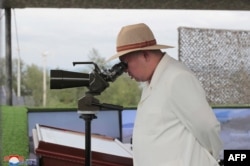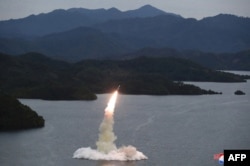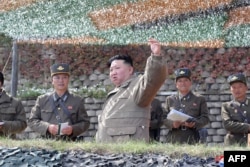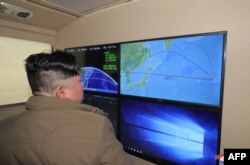North Korea says it simulated strikes on strategic South Korean assets as part of weeks of unprecedented missile testing, as well as the launching of what the North called a new type of ground-to-ground intermediate-range ballistic missile that overflew Japan.
The state-run Korean Central News Agency (KCNA) and the party's main broadsheet Rodong Sinmun on Monday issued parallel reports, announcing that leader Kim Jong Un, who had been absent from the public eye for a month, guided military drills of the Korean People's Army (KPA).
Taking place from September 25 to October 9, the seven rounds of ballistic missile drills checked and assessed the "operation of tactical nukes," North Korean state media reported, together with the military's "nuclear counterattack capability," which would serve as a "severe warning to the enemies."
Corresponding images showed short-range ballistic missiles (SRBMs) exploding in the air, on land targets and via a "super large" multiple rocket launch system, known to U.S. and South Korean officials as the KN-25.
Tactical nuclear operation units confirmed the state's nuclear combat readiness, military effectiveness and actual war capabilities, state media said, as shown in their ability to "hit and wipe out" targets at the intended time and place.
The North Korean leader was cited as dismissing calls from Washington and Seoul to return to talks without preconditions, saying there was neither necessity nor content for discussion with the "enemies."
Instead, he called for a "clearer signal to the enemies escalating the regional situation" that North Korea was powerful and resolute in its will to maintain its "strongest nuclear response posture" to defend its right to exist.
Targeting South Korea
The latest flurry of ballistic testing began at an unconventional location: a silo within a reservoir in the northwestern part of North Korea in the early hours of September 25, according to state media. The new type of launchpad highlighted Pyongyang's embedded message that it was able to send up an SRBM from more locations than ever before.
Its drills three days later were aimed at "neutralizing" airports in South Korea, state media said. Two of its latest missile launches this month – on October 6 and October 9 – were simulations targeting South Korea's "main military command facilities" and main ports.
"What I find notable is that these launches are not framed as tests of the missiles themselves, but rather of the units that launched them," tweeted Jeffrey Lewis, professor at the Middlebury Institute of International Studies at Monterey in California. "That suggests these systems are deployed."
State media – which are reporting on the weapons testing for the first time since May – prefaced the string of tactical nuclear weapon drills as being conducted amid "ongoing dangerous military drills," including trilateral anti-submarine exercises held among the United States, South Korea and Japan on September 30 involving the USS Ronald Reagan Carrier Strike Group.
The Central Military Commission of the Workers' Party of Korea (WPK) decided to send a "more powerful and clear warning on October 4," they said, by targeting waters "in the Pacific 4,500 kilometers across the Japanese Islands with [a] new-type [of] ground-to-ground intermediate-range ballistic missile."
Air drills were conducted on October 6 and October 8. Last Thursday's involved air-to-surface target practice on an islet with medium-range guided bombs and cruise missiles, then with long-range artillery, North Korea said. Two days later, 150 fighter jets simultaneously took off for various missions "for the first time in history," state media said, as another naval exercise involving the U.S. carrier was ongoing further south.
South Korea's military had reported eight fighter jets and four bombers that flew toward the border area last Thursday, not breaching a previously agreed buffer zone that precedes the heavily fortified Cold War-era demilitarized zone.
There was no official comment from South Korea's presidential office or military to the claims made on Monday. Senior presidential press secretary Kim Eun-hye, one day prior, had said that the people would be defended by a strong South Korea-U.S. alliance and the trilateral security cooperation with Japan, adding that Seoul would take an overly ready security posture.
'Very clear political message'
Analysts say the latest display of apparent strides made in North Korea's various nuclear delivery systems is cause for solemn concern, pushing the likelihood of a complete, verifiable and irreversible denuclearization of the Korean peninsula further out of reach.
"They launched a total of 12 missiles of more than five different types and none of them failed," notes Park Won-gon, North Korean studies professor at Ewha Womans University in South Korea.
"There is a very clear political message there; they are showing all of the capabilities of the tactical nuclear weapons [to underscore that it is] very unreasonable to call for the full denuclearization of North Korea. … It means that finally, North Korea has a very high chance to be acknowledged by the United States as a de facto nuclear weapon state."
The next desirable scenario in Pyongyang's point of view would be to enter arms control talks, experts say, which would affirm North Korea as an official nuclear weapons-bearing state.
North Korea's seven ballistic missile tests within a span of 15 days also showed that its tactical missiles have South Korea, Japan and the U.S. territory of Guam within range.
This leads to new territory and the next dilemma to grapple with, Park said, "to deter the actual use of North Korea's nuclear weapons because North Korea is trying to lower the barrier to use the nuclear weapons as Russia is doing right now." Russian President Vladimir Putin has threatened the use of nuclear weapons against Ukraine in an invasion that now is in its eighth month.
The detailed reporting of the short- and intermediate-range missile launches was issued on North Korea's 77th anniversary of the founding of the state's only political party, the Workers' Party of Korea (WPK).
Park said the fact that the weapons drills were unveiled to a domestic audience in nearly half a year via its main newspaper, the Rodong Sinmun, suggests that Kim Jong Un could be warming up his people for more action, a seventh nuclear test.















